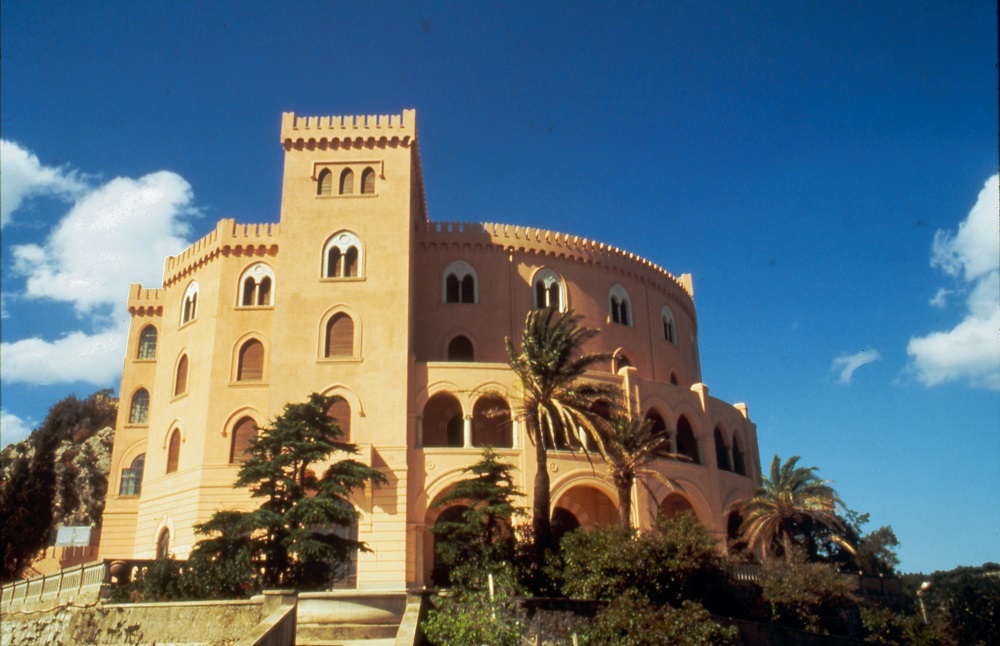
Read Italiano version
Nel 1927 il Cavaliere acquistò dal Comune di Palermo le aree necessarie per l’edificio e su progetto di Giovan Battista Santangelo, professore della Facoltà di Ingegneria dell’Università di Palermo, la costruzione iniziò nel 1928.
L’intera struttura – l’edificio principale, la strada di accesso con il ponte, l’arredo esterno, i grandi serbatoi di acqua potabile, l’impianto di sollevamento e i magazzini – fu realizzata in soli 5 anni dall’impresa “Utveggio e Collura”, che a Palermo aveva già realizzato importanti opere di edilizia pubblica e privata, come Il Cine-Teatro Utveggio di Piazza Massimo, lo Stadio della Favorita, etc..
Il Grand Hotel non ebbe alcuna fortuna, se non per pochissime stagioni. Già alcuni anni prima del secondo conflitto mondiale, la struttura cadde in declino e la situazione precipitò con la guerra: l’area del Primo Pizzo diventò sede della contraerea fascista prima, di quella tedesca poi ed infine di quella americana. Il Castello, rimasto in stato di totale abbandono, divenne oggetto di saccheggio ed atti vandalici. La Regione Siciliana, divenuta proprietaria per esproprio del complesso, ha avviato nel 1984 il recupero dell’edificio provvedendo a ripristinare gli arredi interni ed esterni, dotando la struttura delle più avanzate tecnologie informatiche e di comunicazione. Fino a qualche anno fa il castello è stato sede del CERISDI, Centro Ricerche e Studi Direzionali.
ENGLISH
The castle was at first a great exclusive hotel thanks to an idea of Cavaliere Michele Utveggio, a builder.
The Grand Hotel Utveggio was inaugurated in 1934, but did not have a great fortune despite the innovative and complete accommodation, even equipped with an autonomous system for the water supply.
In 1927 Utveggio bought the necessary areas for the building from the City of Palermo and followed the design by Giovan Battista Santangelo, a professor of the Faculty of Engineering of Palermo University. The construction began in 1928.
The work was entirely funded by private individuals, as well as the connecting route to the existing road network.
The entire structure – the main building, the access road to the bridge, the outdoor furniture, the large reservoirs of drinking water, the lifting facility and the warehouses – was completed in just five years by the “Utveggio & Collura” which had already created important works of public and private buildings in Palermo, such as the Cine-Teatro Utveggio in Massimo Square, the Stadium della Favorita, etc.
The Grand Hotel had no luck, except for few seasons. A few years before the Second World War, the structure fell into decline and the situation worsened during the war: the area of the First Pizzo became firstly the seat of the fascist antiaircraft batteries, secondly of the German batteries and then of the American ones. The Castle, remained in a state of decay, became the object of looting and vandalism. The Sicilian Region, which became the owner for expropriation of the complex, started the recovery of the building in 1984, trying to restore indoor and outdoor furniture, equipping the structure of the most advanced multimedia Technologies. Up to a short time ago it was the site of a School of Excellence: the CERISDI, Center for research and management Studies.
Closed
